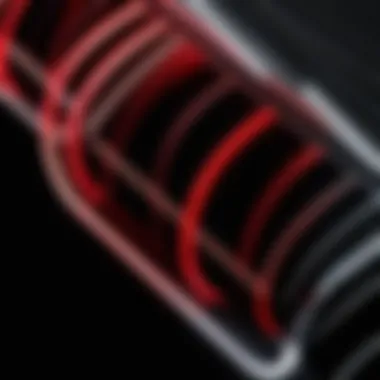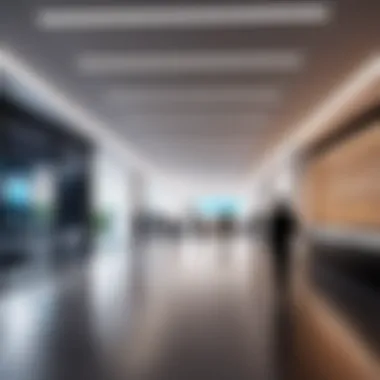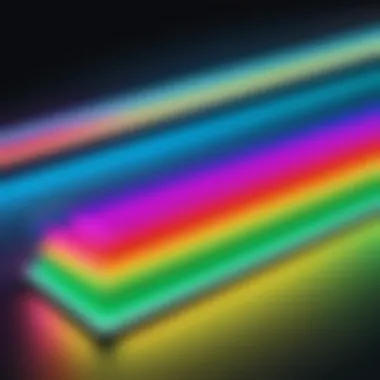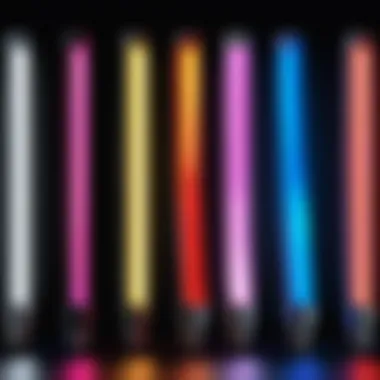Exploring the Efficacy and Applications of LED Flow Lights


Intro
In today's lighting industry, LED flow lights have emerged as a significant innovation. Their adaptability, energy efficiency, and vibrant illumination make them a preferred choice for various applications. This article will guide the reader through the essentials of LED flow lights, detailing their purpose, benefits, and key features, while comparing them to traditional lighting solutions.
The following sections will cover technical specifications, competitive analysis, installation guidelines, and common issues faced during use. By the end of this exploration, readers should have a clearer understanding of how LED flow lights can enhance both commercial and personal environments.
Overview of the Product
LED flow lights are designed to provide reliable and efficient lighting suitable for various settings. These lights are distinct for their ability to produce dynamic lighting effects, often used in decorative or functional capacities.
Purpose and Benefits
LED flow lights serve multiple purposes. They are prevalent in venues such as retail displays, automotive lighting, gaming setups, and architectural illumination. The main benefits of these lights include:
- Energy Efficiency: Consuming significantly less power than traditional incandescent bulbs.
- Longevity: Offering a longer lifespan, making them cost-effective over time.
- Versatility: Available in multiple color options and designs, adaptable for any aesthetic.
Target Audience
The primary audience for LED flow lights includes:
- Tech Enthusiasts: Individuals who value advanced lighting technology in their gadgets and setups.
- Gamers: Those who appreciate customizable lighting to enhance their gaming ambiance.
- Interior Designers: Professionals seeking innovative lighting solutions for their projects.
Key Features
LED flow lights come equipped with several key features that distinguish them from traditional options:
- Color Customization: Ability to change colors and intensities using smart controls.
- Remote Control Options: Enhanced user convenience with mobile and remote settings.
- Environmentally Friendly: Non-toxic materials and reduced carbon footprint.
Technical Specifications
When assessing LED flow lights, the technical specifications are crucial for determining their efficacy and suitability for specific applications.
Detailed Product Specs
Key technical specifications often include:
- Power consumption: Typically between 10-30 watts.
- Luminous output: Ranges from 800 to 3000 lumens depending on the model.
- Beam angle: Varies, commonly between 120 to 180 degrees.
CPU Characteristics
While LED flow lights do not require a CPU in the traditional sense, those equipped with smart technology might use basic microcontrollers for color and timing functions.
Performance Benchmarks
Performance metrics can be gauged through:
- Brightness tested in lumens: Higher lumens signify better visibility.
- Color rendering index (CRI): A measure of how accurately lights render colors.
- Energy efficiency: Typically measured in lumens per watt.
Comparison with Similar Products
To understand the value of LED flow lights, comparison with existing alternatives is necessary.
Market Competitors
Some notable competitors in the LED lighting market include Philips Hue, LIFX, and Govee. Each brand has unique features and innovations.
Comparative Analysis
In comparison to incandescent and fluorescent lights, LED flow lights offer superior energy savings and longevity. They have a starting price that might be higher but provide significant cost savings over their lifespan.
Best Use Cases
LED flow lights are ideal for:
- Ambient lighting in living spaces
- Accentuating architectural features in commercial buildings
- Customizable lighting setups for gaming and entertainment
Installation and Setup Guide


Installing LED flow lights can be straightforward, yet some tips can optimize their effectiveness.
Requirements for Installation
Basic requirements often include:
- Access to electrical outlets
- Possible extension cords or connectors, depending on layout
- Mounting hardware if needed
Step-by-Step Process
- Determine the installation location and plan the layout.
- Secure the lights using the provided mounting accessories (if applicable).
- Connect to power source, ensuring all connections are secure.
- Configure settings using the appropriate remote or app interface.
Tips for Optimizing Setup
- Experiment with light angles to achieve desired effects.
- Use smart home integrations for optimized control.
Answers to Common Questionss and Troubleshooting
Users may encounter common questions and issues regarding LED flow lights.
Common Issues and Solutions
- Flickering Lights: Check for loose connections or incompatibility with dimmers.
- Color Issues: Reset the device or ensure the app is updated.
Expert Tips
- Regularly clean the lights to maintain brightness.
- Explore user forums like Reddit for shared experiences and solutions.
Preamble to LED Flow Lights
The use of LED flow lights represents a significant evolution in lighting technology. Understanding their relevance can provide profound insights into their application across various fields. This introduction serves as a prelude to discussing both the technical and practical aspects of LED flow lights, elucidating why they have gained traction in both consumer and commercial arenas.
LED flow lights demonstrate energy efficiency and versatility that traditional lighting options often lack. This discussion will cover their definition, historical progression, and numerous applications. By comprehending these essentials, readers can appreciate the broader context of LED lighting and its transformative potential.
Definition and Concept
LED flow lights refer to a specific lighting technology that utilizes light-emitting diodes to produce illumination. They are designed to create dynamic light displays, often incorporating color changes and patterns. The fundamental concept behind LED flow lights lies in their ability to function efficiently while offering customizable lighting experiences.
These lights can be tailored to various environments, from atmospheric effects in entertainment spaces to practical uses in gaming setups. Their definition transcends mere illumination; they serve as significant design elements that influence mood, emphasize storytelling, and enhance user engagement.
History and Evolution
The history of LED flow lights reflects a broader narrative of lighting technology. The development began in the early 1960s with the introduction of the first LEDs by Nick Holonyak Jr. Aimed at indicator lights, this initial phase was not dedicated to creating ambient or decorative lighting. However, advancements continued through the decades, leading to the incorporation of LEDs into various applications.
By the 1990s, researchers enhanced LED brightness and efficiency, expanding their commercial viability. This period saw the birth of RGB LED technology, allowing for color mixing and a new dimension of lighting design. As technology progressed, the introduction of smart lighting systems further streamlined their use in contemporary settings. Now, LED flow lights have established themselves not only in aesthetic and functional lighting but also in smart homes, entertainment industries, and automotive applications.
Technical Aspects of LED Flow Lights
Understanding the technical aspects of LED flow lights is crucial for appreciating their functionality and advantages. These lights rely on advanced technology that not only enhances illumination but also improve efficiency. Key elements include the working principles, materials involved, and energy efficiency, all contributing positively to its applications in varied environments.
How LED Flow Lights Work
LED flow lights utilize light-emitting diodes (LEDs) to produce illumination. These diodes function without a filament, which is a significant departure from traditional incandescent bulbs. When an electric current passes through the semiconductor material, it emits light.
The design allows for various color outputs, which can be adjusted as per need. This capability is pivotal in applications like gaming or custom builds where color-matching with components is critical. In effect, LEDs operate at lower temperatures, which minimizes heat output, enhancing safety while improving longevity.
Components and Materials Used
LED flow lights consist of several components that contribute to their overall efficiency and design. Key materials include:
- Semiconductors: The core of LED technology, responsible for light emission.
- Heat sinks: These dissipate excessive heat, ensuring the components function optimally.
- Diffusers: They help distribute light evenly, minimizing hotspots and shadows in the desired area.
- Drivers: These regulate power, ensuring that the LEDs receive the correct voltage and current.
The interplay of these elements determines the performance, cost-effectiveness, and versatility of LED flow lights. Choosing high-quality components contributes to superior operational reliability and longer lifespans.
Power Consumption and Efficiency
One significant advantage of LED flow lights is their exceptional power efficiency. Compared to traditional incandescent or fluorescent lighting, LEDs consume significantly less energy for the same amount of light output.
For instance, while a 60-watt incandescent bulb may only produce about 800 lumens, an LED light can generate the same brightness using only around 10 watts. This translates into lower electricity bills and a lesser environmental impact due to reduced overall energy consumption.


In summary, understanding the technical aspects of LED flow lights sheds light on why they have become a preferred option in contemporary lighting solutions. Their effectiveness lies in their design and energy efficiency, making them suitable for a range of applications, from commercial uses to personal spaces.
Applications of LED Flow Lights
The applications of LED flow lights are vast and varied, spanning numerous sectors. Understanding how these lights can be utilized is crucial for both consumers and professionals alike. Each application area offers unique benefits and presents particular challenges. This insight aids informed decision-making, especially for sectors heavily reliant on lighting solutions.
Commercial Uses
In commercial settings, LED flow lights have become essential due to their efficiency and versatility. Businesses such as retail stores, restaurants, and offices have adopted these lights due to their ability to enhance ambiance while reducing electricity costs.
- Shop Displays: LEDs attract customers by illuminating products effectively. Good lighting can influence buying decisions significantly.
- Task Lighting: In offices, LED flow lights provide adequate illumination for workspaces, making them ideal for improving productivity.
- Flexibility: Many commercial establishments use customizable LED flow lights, allowing them to change colors or intensity based on the time of day or occasion.
This adaptability is a significant advantage over traditional lighting systems, which often lack this ability.
Home and Residential Settings
In residential environments, LED flow lights improve both aesthetics and functionality. These lights offer homeowners an opportunity to leverage innovative designs for various applications.
- Accent Lighting: LED flow lights can highlight architectural features, artwork, or landscaping, creating a pleasing atmosphere.
- Energy Conservation: Homeowners find that switching to LED flow lights reduces energy bills significantly.
- Mood Enhancement: Smart LED systems allow users to customize colors and brightness, transforming room ambiance by simply adjusting settings.
This usage aligns with a growing tendency among homeowners to prioritize sustainable and stylish options in home design.
Automotive and Transport Sector
In the automotive world, LED flow lights enhance both safety and aesthetics. Vehicles fitted with LED lighting not only look modern but also improve visibility on the road.
- Tail Lights and Headlights: LEDs are brighter and more durable than conventional bulbs. This allows for quicker response times in emergencies.
- Interior Lighting: Many modern vehicles use LED flow lights for cabin lighting, providing a sleek and customizable driving experience.
- Signal Lights: Use of LEDs for turn signals is becoming standard. They light up faster, alerting other drivers sooner.
Overall, LED technology is quickly becoming the norm in automotive manufacturing, reflecting the industry's lean towards innovation.
Event and Entertainment Applications
LED flow lights are a staple in the events and entertainment industry. They play a crucial role in creating engaging and immersive experiences.
- Concerts and Festivals: These lights can produce vibrant effects that elevate the overall atmosphere, enhancing the experience of attendees.
- Venues and Theaters: Properly designed lighting setups in theaters can affect mood and perception, influencing the audience's experience.
- Exhibitions and Trade Shows: LED flow lights help attract and guide visitors within spaces filled with numerous displays.
The ability to manipulate these lights dynamically means they can adjust in response to the atmosphere instantly, providing endless creative possibilities.
LED flow lights engage the audience in ways traditional lighting cannot over time, making them fundamental for event planners.
This breadth of application demonstrates just how integral LED flow lights have become across diverse fields, providing benefits in energy efficiency, aesthetics, functionality, and safety.
Benefits of LED Flow Lights
The benefits of LED flow lights are numerous and significant, making them an essential component not only in lighting technology but also in practical applications across various sectors. Understanding these benefits can help consumers and industry stakeholders make informed decisions regarding their implementation and usage. From energy efficiency to environmental considerations, these factors contribute to the growing preference for LED flow lights over traditional lighting options.
Energy Efficiency Compared to Traditional Options
Energy efficiency is one of the most compelling reasons favoring LED flow lights. These lights consume significantly less power compared to incandescent and fluorescent bulbs. In general, LEDs can operate at about 75% less energy. This translates to lower electricity bills and a reduced carbon footprint. With rising energy costs, the long-term savings can be notable.
Homeowners and businesses alike are increasingly seeking ways to optimize their energy consumption. The adoption of LED flow lights is a practical approach, resulting in substantial savings over time. Lights such as the Philips Hue can adapt their brightness levels automatically, ensuring that energy use is minimal when full brightness is unnecessary.
Longevity and Maintenance Considerations
Another key advantage is the longevity of LED flow lights. Unlike traditional bulbs that may burn out more quickly, LEDs have a lifespan of up to 50,000 hours or more. This means fewer replacements and lower maintenance costs. For example, replacing incandescent bulbs repeatedly can be both costly and inconvenient over time.
Less frequent replacement means less waste generated, which also aligns with sustainability efforts. The maintenance for LED lights is minimal, enhancing their appeal in both household and industrial settings. Many LEDs are designed to withstand environmental challenges too, such as vibration and extreme temperatures.
Versatility in Design and Usage
The versatility of LED flow lights further amplifies their benefits. They come in an array of colors, designs, and sizes that can fit various applications—from decorative lighting in homes to industrial lighting in warehouses. This adaptability allows for creative expression in personal and commercial settings.
Moreover, LED flow lights can be easily integrated into smart home systems. They can be programmed, dimmed, and changed in color through mobile applications, making them user-friendly and appealing in today's technologically driven environment. Their compact size means they can also fit into spaces where traditional bulbs cannot.
Safety and Environmental Considerations
Safety is an essential factor when discussing lighting options. LED flow lights emit very little heat in comparison to incandescent bulbs, which can pose a fire hazard. This cooler operation makes them safer for various applications, particularly in areas with limited ventilation.


Additionally, LEDs are often considered more environmentally friendly. They do not contain hazardous materials like mercury, which can be found in some other lighting options. Furthermore, their reduced energy consumption means lower greenhouse gas emissions in power generation.
Challenges and Limitations
Understanding the challenges and limitations of LED flow lights is essential for making informed decisions about their use. Despite their numerous advantages, several factors can hinder their widespread adoption and might affect overall user experience. Analyzing these aspects can guide consumers and businesses in choosing appropriate lighting solutions that meet their specific needs.
Initial Cost vs.
Long-term Savings
When considering LED flow lights, one must evaluate the initial cost against potential long-term savings. LED lights typically have a higher upfront cost compared to traditional incandescent or fluorescent bulbs. This price point can deter consumers, especially those not fully aware of the long-term benefits.
However, the long-term savings become evident through reduced energy consumption and lower replacement costs. LED lights generally have a lifespan of up to 25,000 hours or more, significantly exceeding that of conventional lighting. This longevity reduces the frequency of replacements and enhances value over time.
In addition to the lifespan, energy efficiency plays a critical role. According to the U.S. Department of Energy, LED lights use up to 75% less energy than incandescent lighting, leading to substantial reductions in electricity bills.
“Investing in LED technology might strain your budget initially, but the savings and efficiency over time can be substantial.”
Heat Dissipation and Performance Issues
Another challenge that LED flow lights face is related to heat dissipation. LEDs produce less heat in comparison to traditional bulbs. Nonetheless, they do generate some heat, which needs to be managed effectively. If an LED light cannot dissipate heat properly, it may lead to performance issues and reduced lifespan.
The design of LED flow lights must ensure adequate heat sinks and ventilation to maintain optimal performance. In some cases, poor heat dissipation negatively impacts brightness and color temperature, leading to inconsistent light output.
For instance, users in environments with high ambient temperatures may notice diminished performance in poorly designed LED systems. Therefore, careful consideration of these factors is necessary when selecting LED flow lights suitable for specific settings.
Market Saturation and Quality Concerns
The rise in popularity of LED flow lights has led to significant market saturation. This saturation presents both opportunities and challenges. While consumers benefit from an extensive variety of products, the crowded market can also make it difficult to discern quality.
With numerous manufacturers producing LED flow lights, quality can vary significantly. Some low-cost options may compromise performance or safety, leading to potential drawbacks. Consumers must be vigilant when sourcing LED products, ensuring they choose reputable brands known for their quality assurance.
When selecting LED flow lights, it’s wise to consult reviews, industry standards, and certifications to ensure the chosen products deliver on their promises. This critical evaluation helps mitigate the risks associated with inferior products that could derail the positive experiences generally associated with LED technology.
Future Trends in LED Flow Light Technology
The landscape of LED flow light technology is evolving rapidly. Understanding the future trends in this field is essential for both consumers and industries. New advancements not only enhance functionality but also provide benefits that extend beyond conventional lighting options. The integration of modern technology with LED applications presents new opportunities for improved energy efficiency, user interaction, and environmental sustainability.
Advancements in Smart Lighting
Smart lighting signifies a significant leap in the capabilities of LED flow lights. With the development of advanced sensors and automation features, users can control lighting with unparalleled precision. Smart systems offer features such as ambient light adjustments and motion detection, allowing lights to respond automatically based on surroundings. For instance, lights can brighten in response to increased activity or dim when no motion is detected.
Research shows that smart lighting systems can reduce energy consumption by up to 70% compared to traditional setups. This efficiency not only lowers electricity bills but also contributes positively to environmental concerns.
Integration with IoT and Automation
The Internet of Things (IoT) is redefining how LED flow lights function within both commercial and residential contexts. By integrating with IoT platforms, these lights become interconnected devices capable of communicating with each other. For example, lighting can be programmed to sync with home automation systems, enhancing user experience. Smart homes that utilize IoT seamlessly integrate lighting with security systems, HVAC controls, and entertainment systems.
The potential applications are substantial. As a result, the future will likely see increased user engagement and customization. Options may include voice activation through digital assistants or customized lighting presets that adjust according to the time of day or specific activities.
Sustainability and Eco-Friendly Innovations
Future innovations in LED technology also prioritize sustainability. Manufacturers are now focusing on reducing the environmental impact through eco-friendly materials and production processes. This focus leads to the creation of lighting solutions that are less harmful to the planet.
Key aspects of sustainability in LED flow lights include:
- Use of recyclable materials in fixtures and packaging.
- Production methods aimed at minimizing waste and energy during manufacturing.
- Development of innovative recycling programs to handle end-of-life products.
This shift towards greener practices aligns with global initiatives aimed at reducing carbon footprints. Consumers increasingly seek eco-friendly products, and companies that commit to sustainability will enhance their market presence.
In summary, the future of LED flow lights is bright with promise. Advancements in smart technology, IoT integration, and sustainable practices drive this evolution. As these trends continue to unfold, they will redefine lighting solutions, making them more efficient and environmentally friendly.
Ending
The exploration of LED flow lights presents a significant avenue for understanding contemporary lighting solutions. The discussion about their efficacy and applications highlights several key elements that underscore their growing relevance in various settings.
Summary of Key Insights
Through our examination, it is clear that LED flow lights offer numerous advantages. They are energy-efficient, boasting longer lifespans than traditional lighting. Their versatility in design allows for wide-ranging applications from commercial setups to personal use. Moreover, they contribute positively to environmental sustainability by reducing energy consumption. The key insights about LED flow lights show a movement towards smarter and more efficient lighting choices. In summary, adopting LED flow lights is not merely a trend; it signals a conscious shift towards better technologies and practices.
Implications for Consumers and Industry
The implications of this technology extend beyond personal choice. For consumers, understanding the benefits can lead to more informed purchasing decisions. For the industry, the integration of LED flow lights can streamline operations, reduce overhead costs, and elevate overall product offerings. Manufacturers and designers must keep abreast of advancements in LED technology to stay competitive.
The future will largely depend on how well the industry adapts to these changes and addresses associated challenges. Overall, consumers and businesses alike should consider the significant potential of LED flow lights in shaping smarter, more efficient lighting solutions for generations to come.



